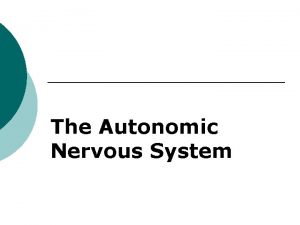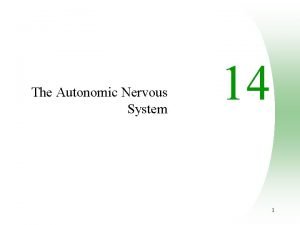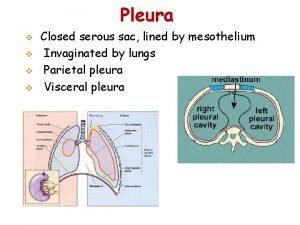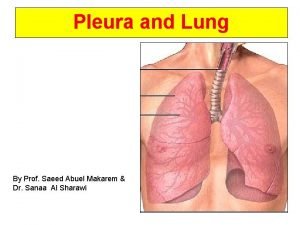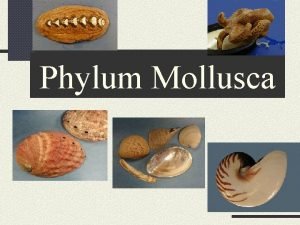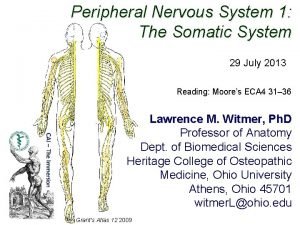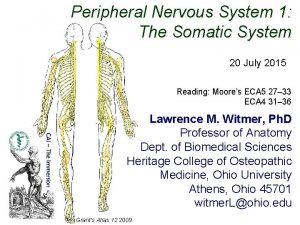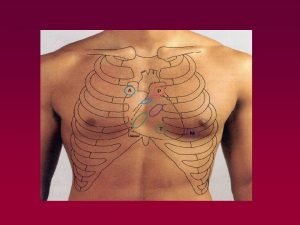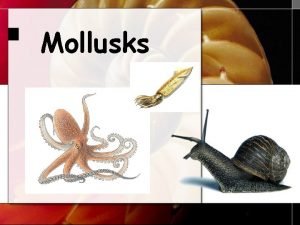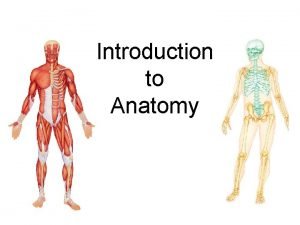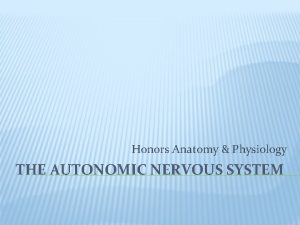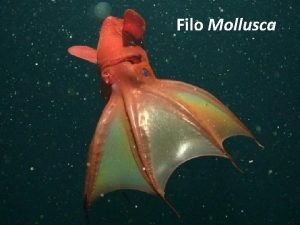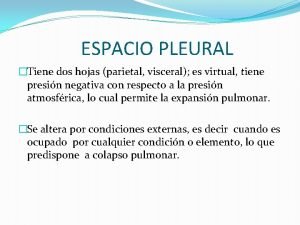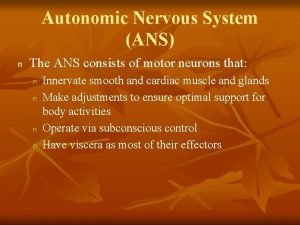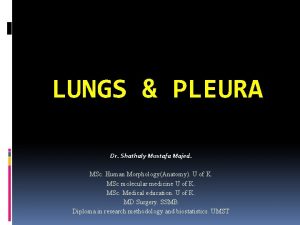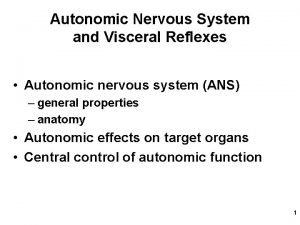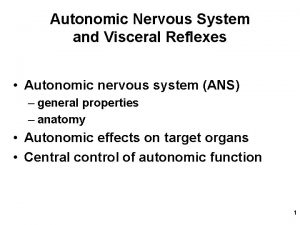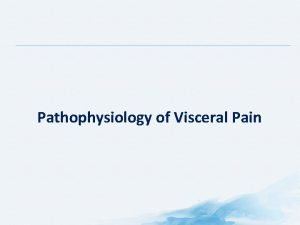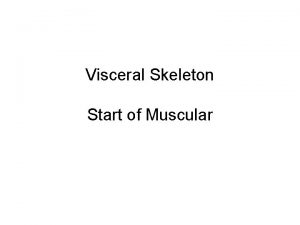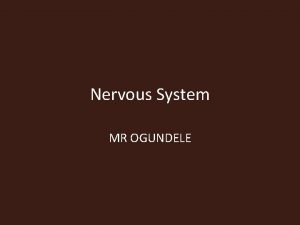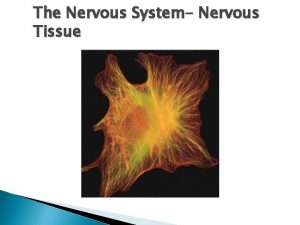The Visceral Nervous System The Visceral Nervous System



































- Slides: 35

The Visceral Nervous System 山东大学医学院 解剖教研室 李振华

The Visceral Nervous System Composition n Visceral motor nerves (autonomic nervous system) q Sympathetic part 交感部 q Parasympathetic part 副交感部 n Visceral sensory nerves

Somatic and Autonomic Nervous System

Main Differences Between Somatic Motor and Visceral Motor n. Somatic Visceral Effectors Skeletal muscles Cardiac, smooth muscles and glands Control Voluntary (consciousness) Involuntary (unconsciousness ) From lower center to effect require Single neuron Two neurons: preganglionic neuron and postganglionic neuron Kind of fibers One Two: sympathetic & parasympathetic Fibers Thick myelinated Preganglionic: thin myelinated postganglionic: unmyelinated Distributive form Nerve trunk Nerve plexuses

Somatic and Autonomic Nervous System

Somatic and Autonomic Nervous System Somatic n n n Skeletal muscle Conscious and unconscious movement Skeletal muscle contracts One synapse Acetylcholine Autonomic n n n Smooth and cardiac muscle and glands Unconscious regulation Target tissues stimulated or inhibited Two synapses Acetylcholine by preganglionic neurons and ACh or norepinephrine by postganglionic neurons

Neurotransmitters SOMATIC NERVOUS SYSTEM ACh AUTONOMIC NERVOUS SYSTEM Sympathetic ACh NE ACh Parasympathetic Ad. M. ACh Striated muscle Heart Sm. mus. Glands ACh Sweat glands ACh Heart Sm. mus. Glands E, NE

Sympathetic Part 交感部 n Lower center: located in intermediolateral nucleus (lateral gray horn) of spinal cord segments T 1~L 3 n Sympathetic ganglia q Paravertebral ganglia 椎旁神经节 q Prevertebral ganglia 椎前神经节

Paravertebral Ganglia 椎旁神经节 n n Arranged on either side of vertebral column Consist of 19~22 of ovalshaped ganglia q q q 3 cervical 10~12 thoracic 4 lumbar 2~3 sacral Ganglion impar 奇神经节: unpaired on the anterior face of coccyx

Paravertebral Ganglia 椎旁神经节 n n n Superior cervical ganglion: largest, situated in front of transverse processes of C 1~C 3 vertebra Middle cervical ganglion: smallest, is at level of transverse processes of C 6 vertebra Inferior cervical ganglion: situated at level of C 7 vertebra, and may be fused with first thoracic ganglion to form cervicothoracic ganglion 颈胸神经节

Paravertebral Ganglia 椎旁神经节

Sympathetic Trunk 交感干 n n n Formed by paravertebral ganglia and interganglionic branches Lie on either side of vertebral column from base of skull to coccyx The trunks of two side unite in front of the coccyx at a small swelling, the ganglion impar

Prevertebral Ganglia 椎前节 n n n Lie anterior to vertebral column and near the arteries for which they are named Celiac ganglion 腹腔神经节 Aorticorenal ganglion 主动脉肾神经节 n Superior mesenteric ganglion 肠系膜上神经节 n Inferior mesenteric ganglion 肠系膜下神经节

Preganglionic Fibers Preganglionic fibers 15 pairs white communicating branches (only spinal levels T 1~L 3 have white communicating branch) Sympathetic trunk

Three Fates of Preganglionic Fibers 1. Relay in corresponding ganglion 2. Ascend or descend in sympathetic trunk and relay in higher or lower ganglia 3. Pass without synapse to a prevertebral ganglion for relay

Preganglionic Fibers n Greater splanchnic nerve 内脏大神经 formed by preganglionic fibers from T 5~T 9 ganglia, and relay in celiac ganglion. n Lesser splanchnic nerve 内脏小神经 formed by preganglionic fibers from T 10~T 12 ganglia, and relay in aorticorenal ganglion. n The postganglionic fibers supply the liver, spleen, kidney and alimentary tract as far as the left colic flexure.

Preganglionic Fibers n Lumbar splanchnic nerve 腰内脏神经 q q Formed by preganglionic fibers from L 1~L 4 ganglia, and relay in prevertebral ganglia. The postganglionic fibers supply descending and sigmoid colon, rectum, pelvic viscera and lower limbs.

Three Fates of Postganglionic Fibers n n n Back to a spinal nerve along gray communicating branches 灰交通支 to terminate in blood vessels, arrector pili muscles and sweat glands of head, neck, trunk and limbs The fibers form their networks around blood vessels passing to visceral end organs Terminate directly in certain organs

Postganglionic Fibers

Distribution of Sympathetic Nerve Preganglionic fibers Postganglionic fibers T 1~T 5 Head, neck, upper limb and thoracic viscera T 5~T 12 Abdominal viscera L 1~L 3 Pelvic viscera and lower limb

Parasympathetic Part 副交感部 n Lower center: located in four pairs parasympathetic nuclei in brain stem and in sacral parasympathetic nucleus of spinal cord segments S 2~S 4 n Parasympathetic ganglia: terminal ganglia are near or within the wall of a visceral organ q Para-organ ganglia 器官旁节 Ciliary ganglion 睫状神经节 n Pterygopalatine ganglion 翼腭神经节 n Submandibular ganglion 下颌下神经节 n Otic ganglion 耳神经节 Intra-organ ganglia 器官内节 n q

Cranial Portion of Parasympathetic Nerve 副交感神经颅部 Ⅲ sphincter pupillae and ciliary muscles ciliary ganglion Ⅶ lacrimal gland pterygopalatine ganglion Ⅸ submandibular ganglion Ⅹ sublingual gland submandibular gland parotid gland otic ganglion terminal ganglia heart, lungs, liver, spleen kidneys, alimentary tract as far as left colic flexure

Cranial Portion of Parasympathetic Nerve Ⅲ accessory oculomotor nucleus 〈○ sphincter pupillae and ciliary muscles ciliary ganglion Ⅶ pterygopalatine ganglion 〈○ lacrimal gland superior salivatory nucleus 〈○ submandibular ganglion sublingual gland submandibular gland Ⅸ inferior salivator nucleus 〈○ parotid gland otic ganglion Ⅹ dorsal nucleus of vagus n. 〈○ terminal ganglia heart, lungs, liver, spleen, kidneys, alimentary tract as far as left colic flexure

Sacral Portion of Parasympathetic Nerve 副交感神经骶部 n n n Preganglionic fibers from sacral parasympathetic nucleus leave spinal cord with anterior roots of the spinal nerves S 2~S 4, Then leave sacral nerves and form pelvic splanchnic nerve 盆内脏神经 and travel by way of pelvic plexus to terminal ganglia in pelvic cavity Postganglionic fibers terminate in descending and sigmoid colon, rectum and pelvic viscera


Main Differences Between Sympathetic and Parasympathetic Sympathetic Parasympathetic Lower center Intermediolateral nucleus (lateral gray horn) of spinal cord segments T 1~L 3 Four pairs parasympathetic nuclei and sacral parasympathetic nucleus Ganglia Paravertebral, prevertebral Terminal Preganglionic f. Shorter Longer Postganglionic f. Longer Shorter Pre: Postganglionic 1: many more 1: a few Distributions Throughout the body Limited primarily to head and viscera of thorax, abdomen, and pelvis Different action Prepares for emergency situation (expends energy) Conserve and restore body energy (conserves energy)

Main Differences Between Sympathetic and Parasympathetic Sympathetic Parasympathetic Different action Prepares for emergency situation (fight or flight) Conserve and restore body energy (rest and relaxation) Pupil Dilates Constricts Heart Increases force of contraction Decreases force of contraction Rhythm of the heart To become more rapid To make slow Blood pressure Heighten Depress Bronchi Dilates bronchi Constricts bronchi

Main Differences Between Sympathetic and Parasympathetic

FUNCTION OF THE IRIS Low light: iris dilates Sympathetic neurone Dilator pupillae Normal light Bright light: iris constricts Sphincter pupillae Pupil Parasympathetic neurone Ganglion

Visceral Plexuses n Cardiac plexuses 心丛 q q n Superficial , below aortic arch Deep, anterior to bifurcation of trachea Pulmonary plexus 肺丛

Visceral Plexuses n n Celiac plexus 腹腔丛 Abdominal aortic plexus 腹主动脉丛 n Hypogastric plexus 腹下丛 q q Superior hypogastric plexus Inferior hypogastric plexus (pelvic plexus)

Visceral Sensory Nerves Nucleus of solitary tract Ⅶ,Ⅸ, Ⅹ Thalamus Enteroceptors Posterior horn Cerebral cortex Hypothalamus Effectors Sympathetic nerve Pelvic splanchnic nerve Somatic motor neurons visceral motor neuclei

Referred Pain牵涉痛 n n Pain originating from organs perceived as coming from skin Site of pain may be distant from organ

Referred Pain牵涉痛 Convergence theory: n n n This type of referred pain occurs because both visceral and somatic afferents often converge on the same interneurons in the pain pathways. Excitation of the somatic afferent fibers is the more usual source of afferent discharge, so we “refer” the location of visceral receptor activation to the somatic source even though in the case of visceral pain. The perception is incorrect. The convergence of nociceptor input from the viscera and the skin.

Referred Pain 牵涉痛
 Adrenal gland sympathetic nervous system
Adrenal gland sympathetic nervous system Dura mater meaning
Dura mater meaning Neuronal pool
Neuronal pool Fundamentals of the nervous system and nervous tissue
Fundamentals of the nervous system and nervous tissue Processes of neurons
Processes of neurons Nervous system and digestive system
Nervous system and digestive system Endocrine system vs nervous system
Endocrine system vs nervous system Amino acid-based hormones
Amino acid-based hormones Endocrine system
Endocrine system Liver ligaments
Liver ligaments Membrane covers the heart
Membrane covers the heart Order of visceral reflex
Order of visceral reflex Sympathetic
Sympathetic Visceral leishmaniasis
Visceral leishmaniasis Transudate vs exudate
Transudate vs exudate Suprapleural
Suprapleural Mediastinal surface
Mediastinal surface Taxonomy
Taxonomy Visceral mass
Visceral mass Bursa omentum
Bursa omentum Visceral afferent vs efferent
Visceral afferent vs efferent Erb palsy
Erb palsy Fibrous and serous pericardium
Fibrous and serous pericardium Omenta
Omenta Massa visceral dos moluscos
Massa visceral dos moluscos Visceral mass
Visceral mass Body planes and sections
Body planes and sections Autonomic reflex arc
Autonomic reflex arc Sistema fonatório
Sistema fonatório Massa visceral dos moluscos
Massa visceral dos moluscos Hipotimpanismo
Hipotimpanismo Somatic reflex vs visceral reflex
Somatic reflex vs visceral reflex Parietal layer and visceral layer
Parietal layer and visceral layer Dolor referido
Dolor referido Cuti visceral reflex
Cuti visceral reflex Pleura parietal visceral
Pleura parietal visceral











